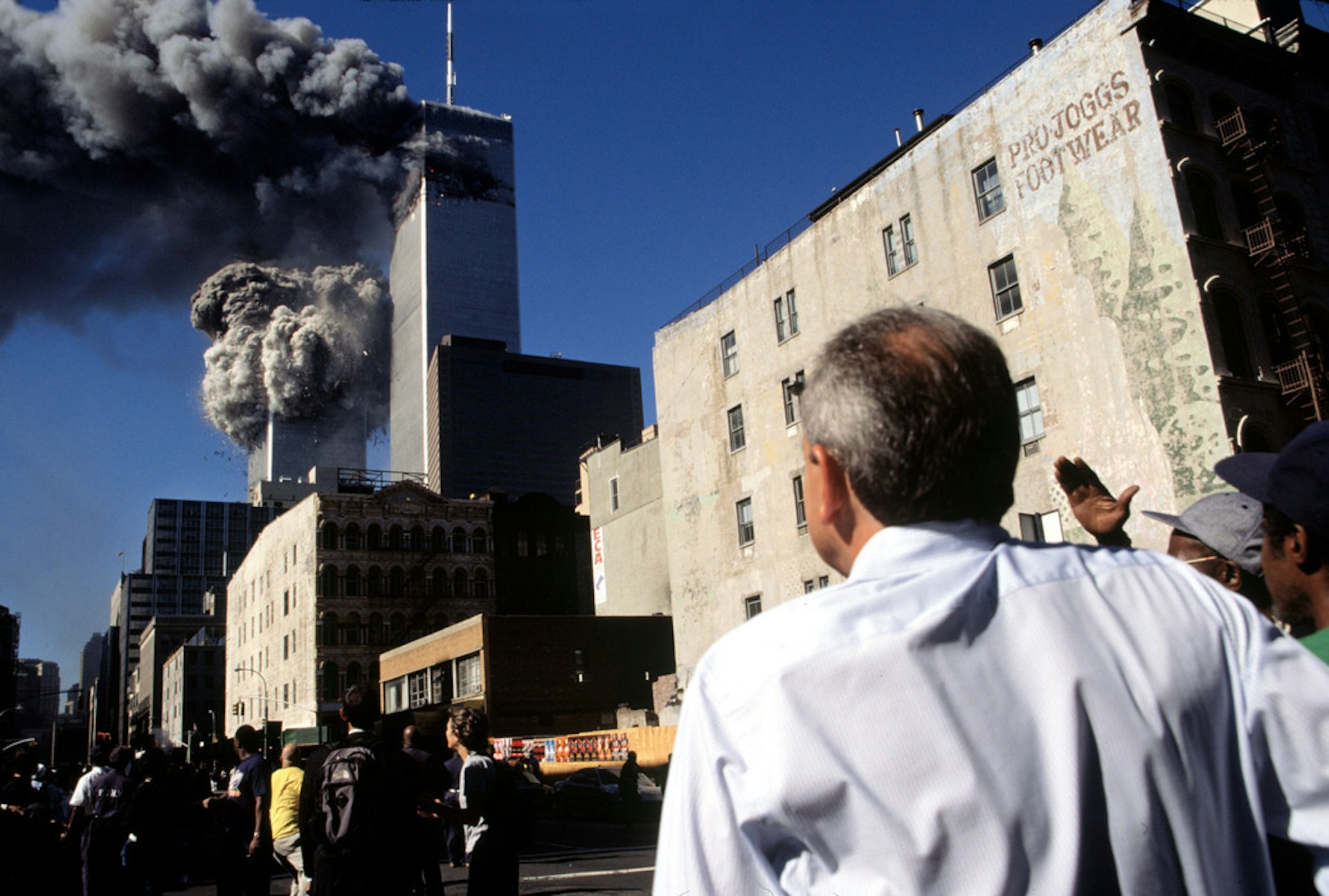
Making sense of conspiracies in a climate of fear
- Text by Cian Traynor
- Photography by As captioned. Featured image: Susan Meiselas / Magnum Photos
Ginnie Watson had been watching the Eagles of Death Metal concert in Paris when terrorists opened fire on the crowd. For a moment, the commotion made it hard to tell what was happening from the balcony. The gunshots seemed like some sort of stunt. But when the band ran offstage, confusion turned to panic. Watson bolted for an emergency exit amid the screams and gunfire, waiting with others in the stairwell until the way out was clear.
She and a friend fled for home, where they watched the news unfolding and tried to process what had happened. At about 4am, having steadied her nerves with a drink, Watson agreed to the first of several media interviews. That’s how the backlash began. Within days, she became inundated with accusations and abuse.
“I couldn’t understand what was happening,” says Watson, a British-French singer and actor. “It was so upsetting that I just could not settle at first. I kept checking my Facebook and going, ‘Oh, there’s another one!’ Then I’d just be deleting, deleting, deleting. I’d never heard of ‘false flags’ until I had all these people saying horrible things to me. ‘How much did the CIA pay you?’, ‘How can you sleep at night?’, ‘I hope you fucking die.’”
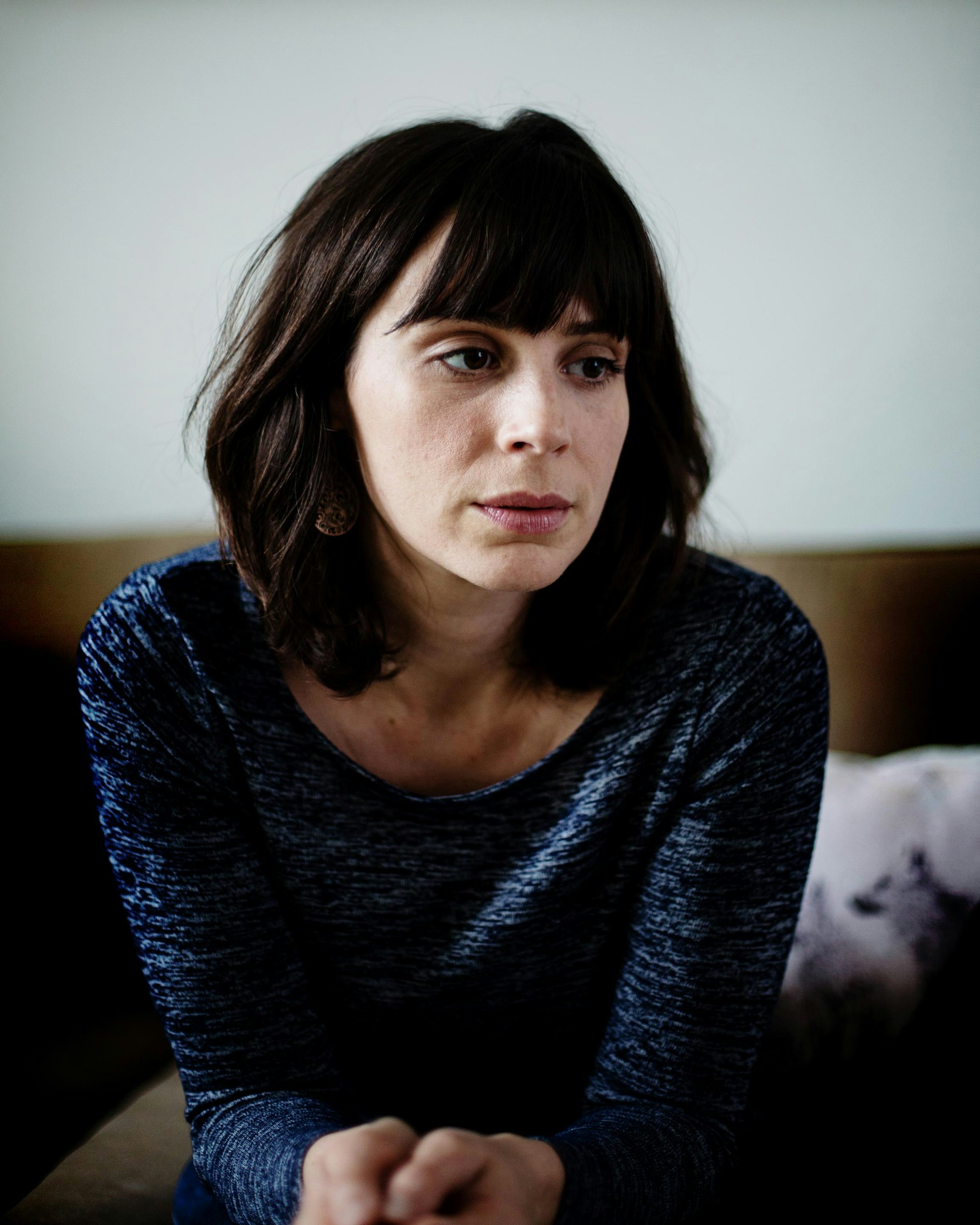
Ginnie Watson, who witnessed the terrorist attacks on Paris, has been accused of deceiving the public by conspiracy theorists. Photo by Julien Pebrel.
A false flag operation is an attack designed to appear as though it was carried out by someone other than the parties responsible. The term originates from naval warfare, when ships would hang the enemy’s flag to disguise themselves during tactical manoeuvres. Today it’s used by conspiracy theorists or ‘truthers’ to describe staged attacks – complete with fictional victims – orchestrated to deceive the public and further a hidden agenda.
People saw the terrorism in Paris, for example, as part of an ongoing campaign to create a police state – one where government agencies engineer hoax tragedies to instil fear and bolster control. A fake Syrian passport found near the body of a suicide bomber was considered a tell-tale sign.
Then there was the timing: coming one day before the G20 summit in Turkey meant terrorism would overshadow all other issues among heads of government. So when French president François Hollande pledged to invoke emergency powers that would constrain civil liberties in the name of safety, it was exactly as conspiracy theorists predicted.
Ginnie Watson’s perceived role in this was that of a ‘crisis actor’: a stooge paid to mislead the public with false witness testimony. People picked apart her statements, scrutinising them for inconsistencies.
Why did her demeanour seem so relaxed? How could she tell the terrorists used Kalashnikovs? She mentioned being with two friends in some interviews, but referred to only one in others – which was it? Finally, when it emerged that Watson happened to be a professional actor, the campaign to expose her gathered momentum – compounding what had already been a traumatic experience.
Today the 36-year-old is speaking from her Parisian apartment over Skype, her little daughter tugging impatiently at her jumper before being shooed into the next room. Having spent some time retreating from the world, she seems genial and level-headed, glad to have the opportunity to defend herself.
The media interviews were not something Watson sought – they came to her – but it did feel like a way of releasing stress. Still, she found herself accused of not looking traumatised and showing signs of ‘duping delight’ – smiles that reveal the unconscious pleasure of getting away with it.
“You don’t know how you’re going to react in a situation like that until it happens to you,” she says. “I didn’t know what was going on in my own head. I didn’t want to break down in front of millions.”
From Watson’s perspective, her story has never changed. She was with two friends but one got separated. Yes, she said ‘Kalashnikovs’ but only because that’s what the coverage reported. There’s a rational explanation for all of it, she adds, but when people look hard enough for something, they’ll find it.
“I totally understand that there are conspiracies out there and that some governments do horrible things,” she says. “All I know is that what I experienced was real. I wasn’t paid. I did see blood. It was a horrible experience and I still think about it all the time. I don’t think I’m over it completely. I’m carrying on because I have to – I’m a positive person in general. But I wouldn’t lie about something like that.”
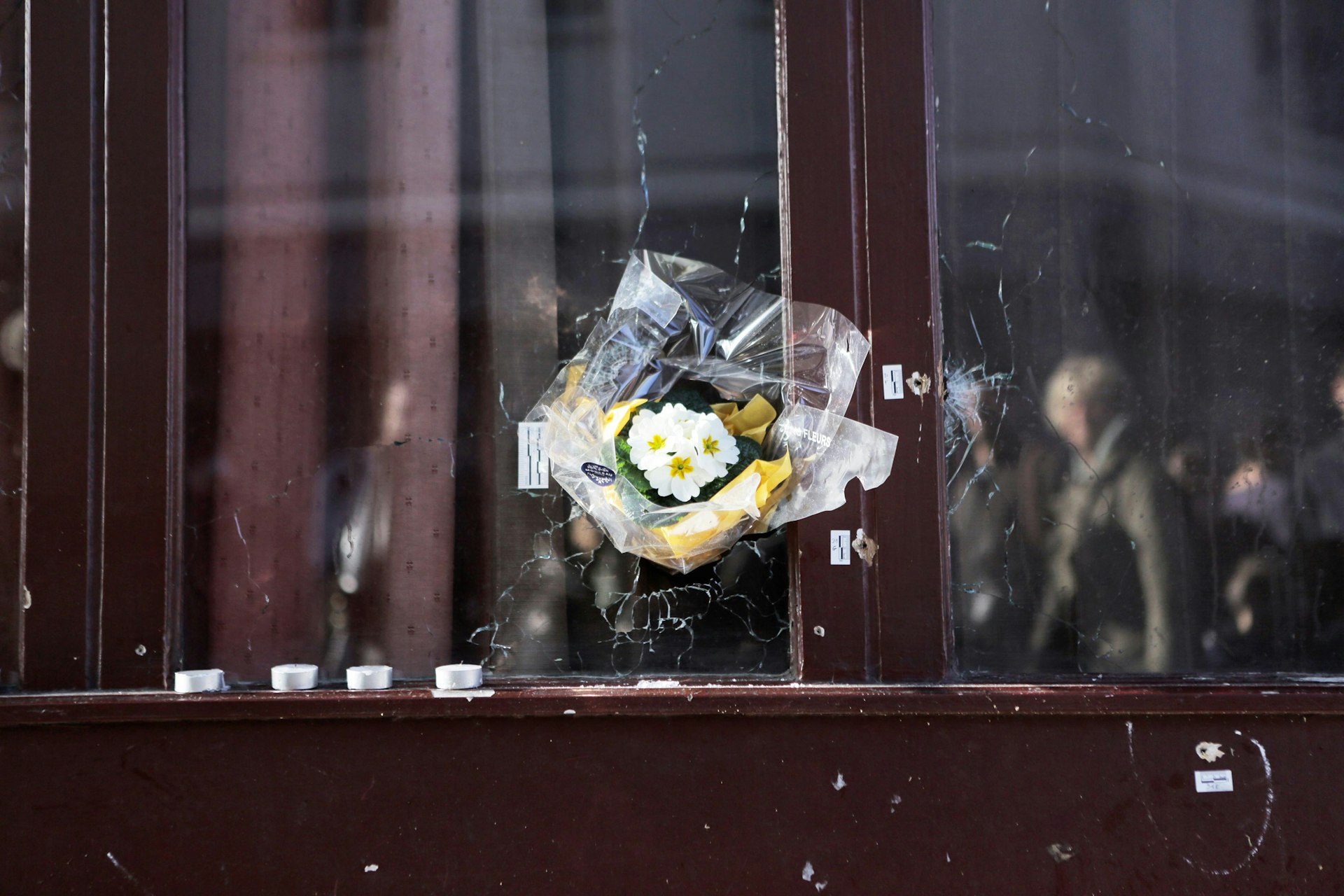
Flowers left in commemoration of those who died in the terrorist attacks on Paris, November 2015. Photo by Daniella Zalcman.
When Jesse Hughes, the frontman in Eagles of Death Metal, claimed that the Bataclan’s security guards were complicit in the massacre, he quickly backtracked and apologised. Hughes had been struggling to make sense of the tragedy, so perhaps reviewing it through the prism of post-traumatic stress isn’t all that surprising. But the mindset of those who scan unfolding tragedies for signs of a hoax, on the other hand, isn’t so easily deciphered.
Jerome Myburgh immediately questioned the validity of the Paris attacks, posting links to Facebook that railed against the official account while describing the scenes as so “pathetically lacking in believability” that they resembled a TV set.
Myburgh, 36, was born in South Africa, grew up in Ireland and now lives in Bolivia, where he runs a garage. He’s easy to get along with, has a boisterous laugh and admits that his views could be regarded as anything from quirky to outlandish. While he doesn’t set out to antagonise others, he does find the public’s lack of scepticism and distaste for counter-narratives alarming.
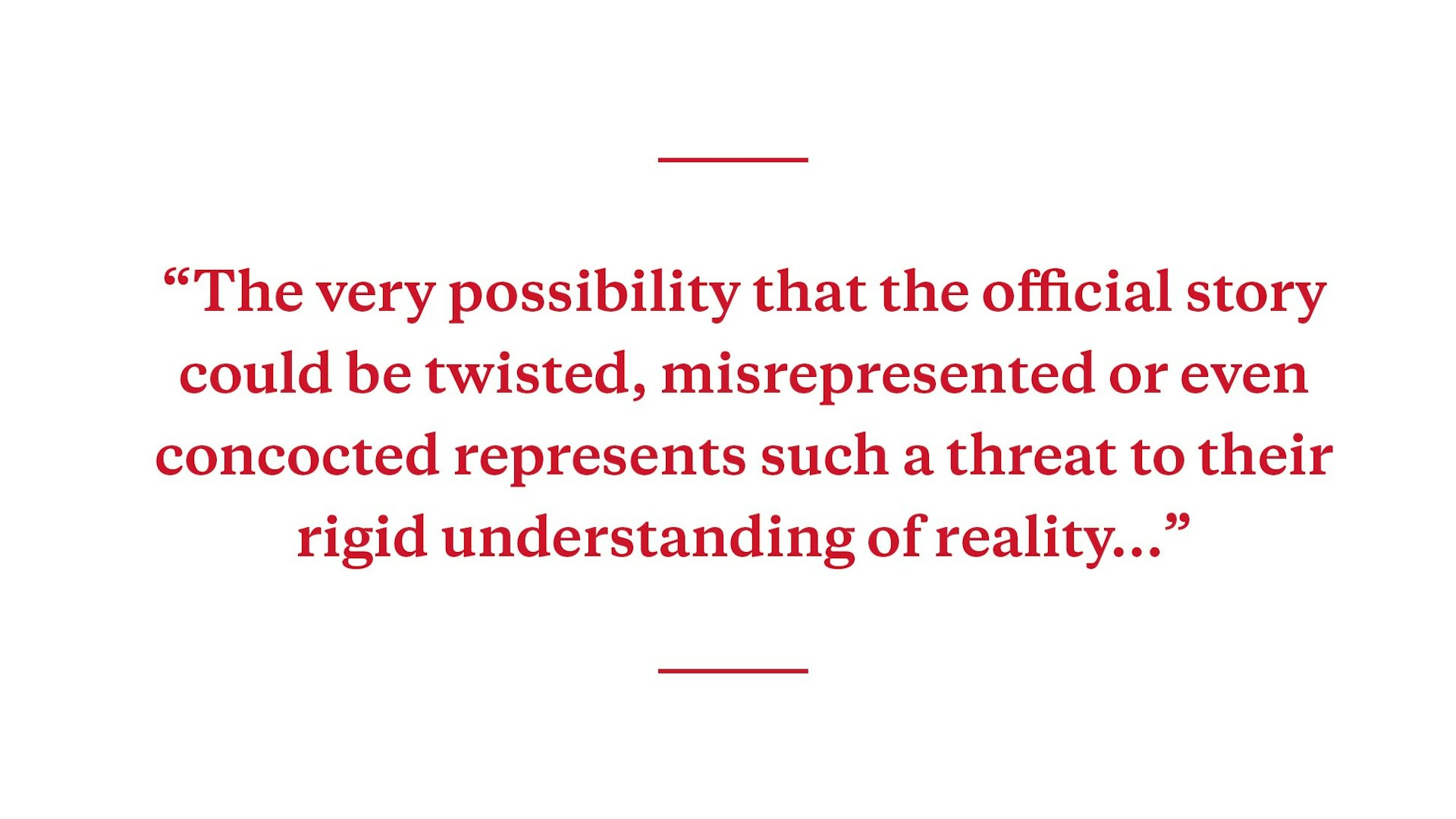
“There is no doubt in my mind that things are sometimes staged, sometimes misrepresented – both to suit an agenda – but that real tragedy also occurs,” he says. “And that so offends people, why? Because the very possibility that the official story could be twisted, misrepresented or even concocted represents such a threat to their rigid understanding of reality that to come apart from it is entirely unthinkable.”
Myburgh developed this perspective after watching the contentious 9/11 documentary Loose Change, which claimed that the Bush administration engineered the destruction of the Twin Towers and that several of the identified hijackers were not on the planes. He gradually poured more and more time into broader historical research until conspiratorial patterns reshaped his understanding of the world.
There were plenty of documented false flags to study: from Operation Himmler, a campaign by Nazi Germany to fabricate Polish aggression before invading Poland, to Operation Northwoods, a US military plot to stage acts of terror in order to start a war with Cuba – a strategy that remained undisclosed to the public until 1997.
Just two years ago, a leaked audio recording purportedly captured Hakan Fidan, the head of Turkey’s National Intelligence Organisation, proposing a false flag incursion into Syria with the words: “Legitimacy is not a problem. Legitimacy can be manufactured.”
But Myburgh cites 9/11 as the perfect example of a false flag. Beyond nagging questions about the mechanics of what happened (How could the explosion bring down metal girders while one of the terrorists’ passports managed to survive intact? How did a third building, World Trade Centre 7, collapse without being hit by an aircraft?), he says the event was clearly a pretext to invade Iraq and introduce unprecedented surveillance measures.
The downside to this sort of research, he says, is that the conclusions are invariably unpleasant and that those who ask questions are dismissed as delusional. But he feels that if the world at large saw conclusive evidence of modern false flags, a shift in consciousness could follow.
“I must admit it makes me feel quite lonely at times and also tends to make me regard the majority of humanity with a certain disdain and contempt in certain matters, but I’m working on that,” he says. “This is a time for me to start believing in the greater global family, not doubting it.”
The mix of conviction, powerlessness and mistrust associated with truthers forms a complex web that researchers are trying to untangle. Christopher Thresher-Andrews is one of them. He’s an associate lecturer in psychology at Goldsmiths, University of London, where he’s developing one of the first studies to actively demonstrate a causal link between feelings of uncertainty and conspiracy belief. In person, the 29-year-old is the epitome of a young professor: erudite, smartly dressed, unfailingly polite. And, yes, he has been accused by conspiracy theorists as working for the government.
It started the day after the 7/7 bombings in London, when Thresher-Andrews searched for more information online and found a website offering answers. The attack had either been planned by the government or faked entirely, it said, and you only had to consult the Tube timetables for proof: one of the trains was not where it should have been when the bomb detonated.
Thresher-Andrews couldn’t believe that someone would make their mind up based on so little evidence, especially when the identities of the assailants hadn’t yet been established. But he could also see how this framing of the story might appeal to a certain type of person, inspiring him to study the language and reasoning behind conspiracy theories.
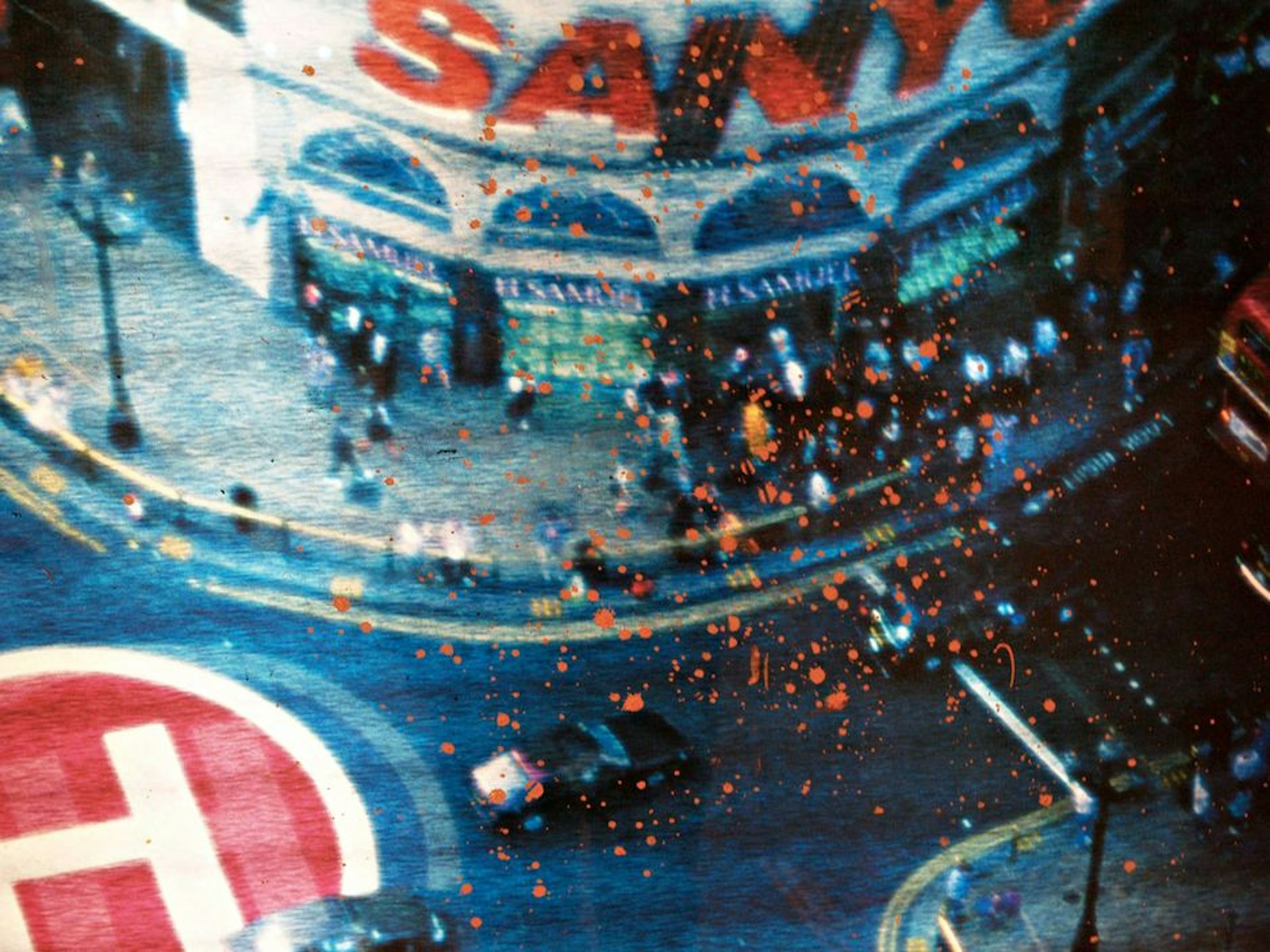
Media coverage of the London bombings, July 7, 2005.
Photo by Christopher Anderson / Magnum Photos.
“I started seeing them everywhere and they all sounded like they were making sense,” he says, sipping a coffee in the lobby of a Shoreditch hotel. “Here was an answer to all our problems: it turned an unfair, uncontrollable world into one that was clear and easy to understand. I didn’t really believe most of them but I thought, ‘Could there be some explanation we’re not being told?’ From that point on I wanted to understand the psychology behind it.”
The root of all conspiracies, he says, is the desire to make sense of a threat to society. But it’s a case of legitimate concerns being misattributed to illogical causes. Take the idea that a cabal of powerful people is controlling everything, he says: you only have to look at the Bilderberg group – an annual invite-only forum for business and political leaders – or the influence of multi-nationals to realise that belief is generally valid.
It’s also fair to say that governments keep secrets and don’t always act in our best interests. But to conclude that they need to stage hoaxes to further their agenda is something he sees as a leap too far.

“I can happily appreciate that the world is a corrupt place where there are people with disproportionate amounts of wealth and power,” he says. “But why, in that case, would they need to resort to such elaborate conspiracies to preserve it? It all comes back to the illusion of control or the lack of it. If you feel you don’t have control over your own life or over certain aspects of government, then someone else must.”
By the time we speak again, hours after a terrorist attack in Belgium, claims of a false flag are already circulating online, with some pointing to the CIA and Mossad as the parties responsible. Turn to social media in the aftermath of any international tragedy – be it June’s mass shooting at a nightclub in Florida, or the terrorist attack in Turkey this week – and you’ll find the same thing.
There’s a religious-like fervour to the stream of videos and posts: people unifying in a collective belief, passionately trying to spread that message, but often dismissing contradictory evidence, too. “I don’t know what’s worse,” says Thresher-Andrews, “feeling like you have an answer to the world’s problems or feeling like you can’t do anything about it.”

Tim Bryant, a self-described ‘free-thinker’, believes that governments stage hoax tragedies as a way of increasing power. Photo by Jessica Chou.
Tim Bryant says that delving into conspiracy research has helped him reach a heightened level of consciousness. He’s a 26-year-old tennis coach who lives in Los Angeles and runs ‘alternative media’ website The Last American Vagabond. Recently he attended a conference: an anarcho-capitalist event, technically, but Bryant prefers to categorise it as a meeting of freethinkers. Four hundred people attended – young and old, men and women, hippies and suits – and Bryant felt encouraged to see so many ‘awakening’.
“When I first came across all this stuff, it was almost like an ego death,” he says. “All that I thought was true was maybe not so true. Once you accept something like 9/11 being an inside job – something that big – it puts a lot of reality into question… I’m not saying I have all the answers but it’s helped me in all types of aspects: from relationships to understanding how the world works at a macro level. I feel more alive than I’ve ever been in my life.”
Bryant is sitting at a desk in his bedroom, speaking over Skype, wearing a black cap and black shirt. A ceiling fan spins above him, sunlight glowing through a narrow window above the back wall. He starts likening his journey of discovery to a drawing he saw online. There’s a guy looking at a beautiful sky – but it’s an illusion. He doesn’t realise it’s just a picture.
Then there’s another guy standing on a pile of books, looking over the picture. Knowledge has allowed him to see past the illusion but now he only sees the harsh reality behind it. Finally, a third man stands atop a tower of books reaching all the way to the sky. Having educated himself to the point of enlightenment, he finally sees the bigger picture.
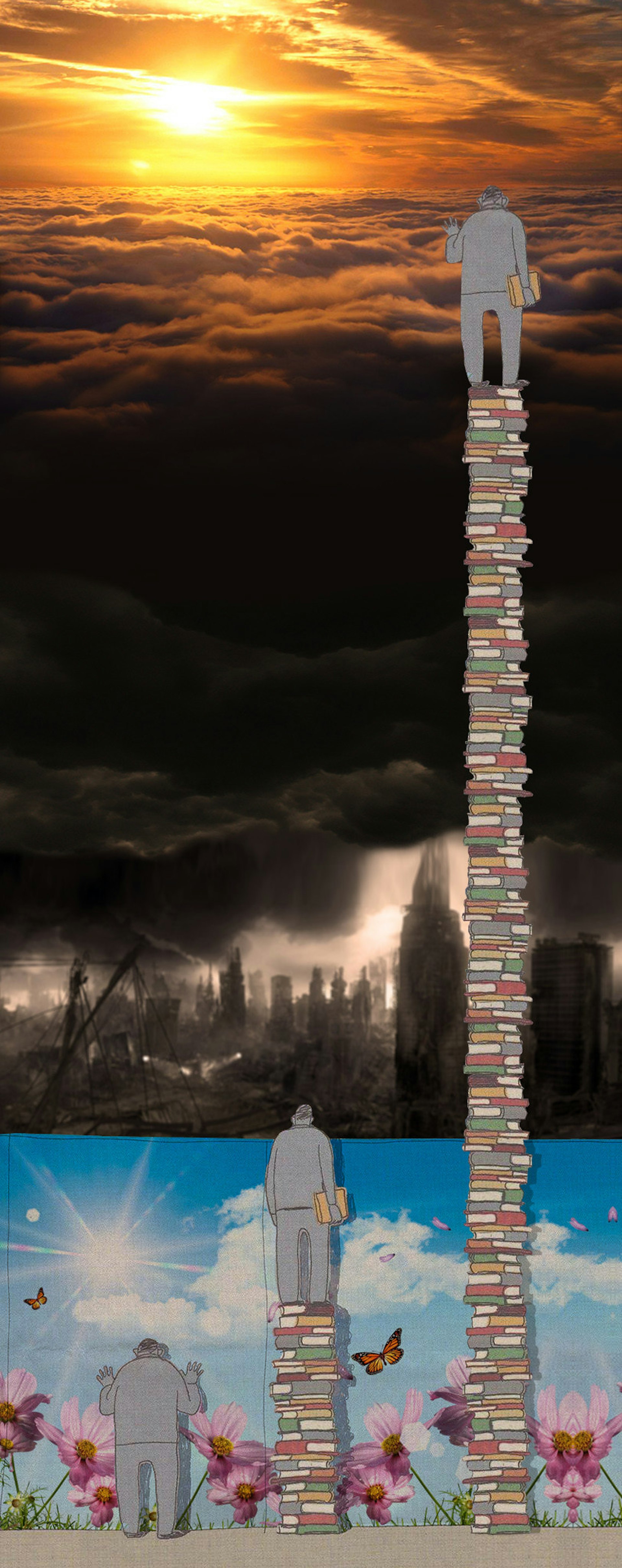
Bryant accepts that some conspiracies can be tough to swallow. Take the mass shooting at Sandy Hook, for example. He’d love to be wrong in thinking it’s a hoax but there are too many things that don’t add up for him. How could a skinny 19-year-old with mental health issues and no military training kill 26 kids in five minutes? Where are the photos of the bodies? Why was one of the victims’ parents, Robbie Parker, smiling and joking right before giving a press conference?
But you can’t just dive straight into questions like these and expect others to be open to them, Bryant says. There’s a skill to ‘waking people up’ that requires empathy, patience and encouraging people to reach their own conclusions.
“When you really want to change things and no one wants to pay attention, it can be very, very frustrating,” he says. “But you’ve got to transcend that. It’s impossible to convince anyone of anything if their mind is already made up. Just spouting information, getting aggressive or using condescending terms like ‘sheeple’ [a nickname for a docile public] is never going to work.”
Still, a stumbling block for many is the question of logistics. Staging an event like a terrorist attack would require lots of complicit people – all without enough moral fortitude to stand up and say, ‘Hang on, I don’t think this is right’. And as Wikileaks, Edward Snowden and the Panama Papers have shown, keeping secrets from the public is harder than ever.
It’s a legitimate point, Bryant says, but everyone’s on a need-to-know basis. Most in government have no idea. It’s only the top players who know what’s happening. But asked what any truther can achieve beyond pointing fingers and raising awareness, all Bryant offers is catching one of the big players and prosecuting them. “That would send a clear message,” he says. “Then people would pay attention.”
It’s a familiar response, says Professor Thresher-Andrews, and part of the logical fallacy he sees as inherent in all conspiracies: to solve the problem, you have to rely on the existing system, which you think is corrupt. The reasoning only brings you in circles.
“The conspiracy theory is, by its nature, defeatist,” he says. “There can’t be a solution because it can never be proven true – there’s always a bit of evidence missing, suppressed by the people behind it. In a sense, it’s almost the perfect answer. You can complain about the world, you can feel superior about knowing something most people don’t, but you don’t have to do anything about it because you’re powerless. The situation is never resolved.”
This article appears in Huck 55 – The Freaked Out Issue. Buy it in the Huck Shop now or subscribe to make sure you never miss another issue.
Enjoyed this article? Like Huck on Facebook or follow us on Twitter.
